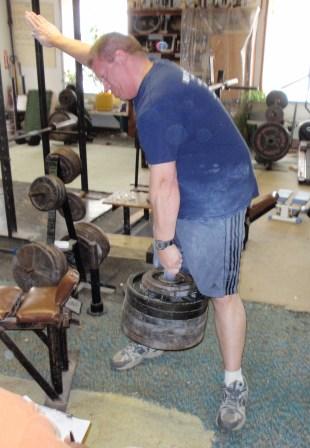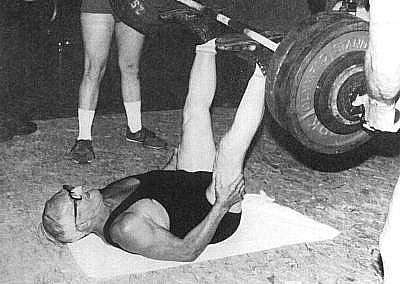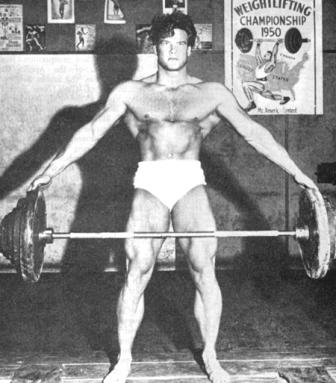Vertical Bar Deadlift – 1 bar, 2″, 1 hand
by Al Myers

Ben Edwards doing a 235 pound Vertical Bar Deadlift - 1 Bar, 2", One Hand. This is the top All-Time record in the USAWA.
This lift was introduced to the USAWA several years ago by John McKean of the Ambridge Barbell Club. Initially it was performed with a 2″ Vertical Bar in each hand, with the lifter completing the lift by standing up with the weight like a normal deadlift. The first recorded meet this lift was done in was 1998, at Art’s Birthday Bash. John McKean first introduced it as a One Hand Lift in 2003 at the Jump Stretch Record Day. Since then the popularity of the 2″ One Handed VB Lift has grown. The first big meet it was held in was the 2004 National Championships, in Youngstown, Ohio. The Vertical Bar has a length limit of 18 inches. The reason this became the USAWA standard length was because the original VB was the sleeve off of an Olympic Bar, measuring just under 18 inches. The USAWA rules on Vertical Bar lifting are quite different than other grip competitions. The big thing to remember is the bar must become completely motionless at the completion of the lift, including any rotation. Another USAWA rule I want to clarify is that in any One Handed lift the same hand must be used throughout all of your attempts. You can’t save “thy strong hand” for “thy hard lift”.
Rules for the Vertical Bar Deadlift
H18. Vertical Bar Deadlift – 1 Bar, 1”, One Hand
The setup for this lift requires a Vertical Bar, which is a bar of one inch diameter with a maximum length of 18 inches. A collar or plate must be tightly fastened or welded to the bottom so plates may be added to the bar. No knurling is allowed on the bar. The lifter may straddle the weight or have it placed to the lifter’s side. Width of feet placement is optional, but the feet must be in line with the torso. Feet must not move during the lift, but the heels and toes may rise. The bar may be gripped by any grip with only one hand near the top of the vertical bar. The forearm is not allowed to touch the bar. The lifting hand must not touch the body during the lift, but the weight may accidentally touch the legs provided it does not aid in the lift. The non-lifting hand may be braced on the leg or body during the lift, but must be free from the body at the completion of the lift. The lift begins at the lifter’s discretion. The body must then straighten, lifting the Vertical Bar from the
platform. The legs must be straight and knees locked at the completion of the lift, but the shoulders and body do not need to be erect. The lifting hand must be above the level of mid-thighs at the completion of the lift. Any rotation of the bar must be completely stopped. Once the weight is motionless, an official will give a command to end the lift.
H19. Vertical Bar Deadlift -1 Bar, 2”, One Hand
The rules of the Vertical Bar Deadlift – 1Bar, 1”, One Hand apply except a two inch diameter Vertical Bar is used.

